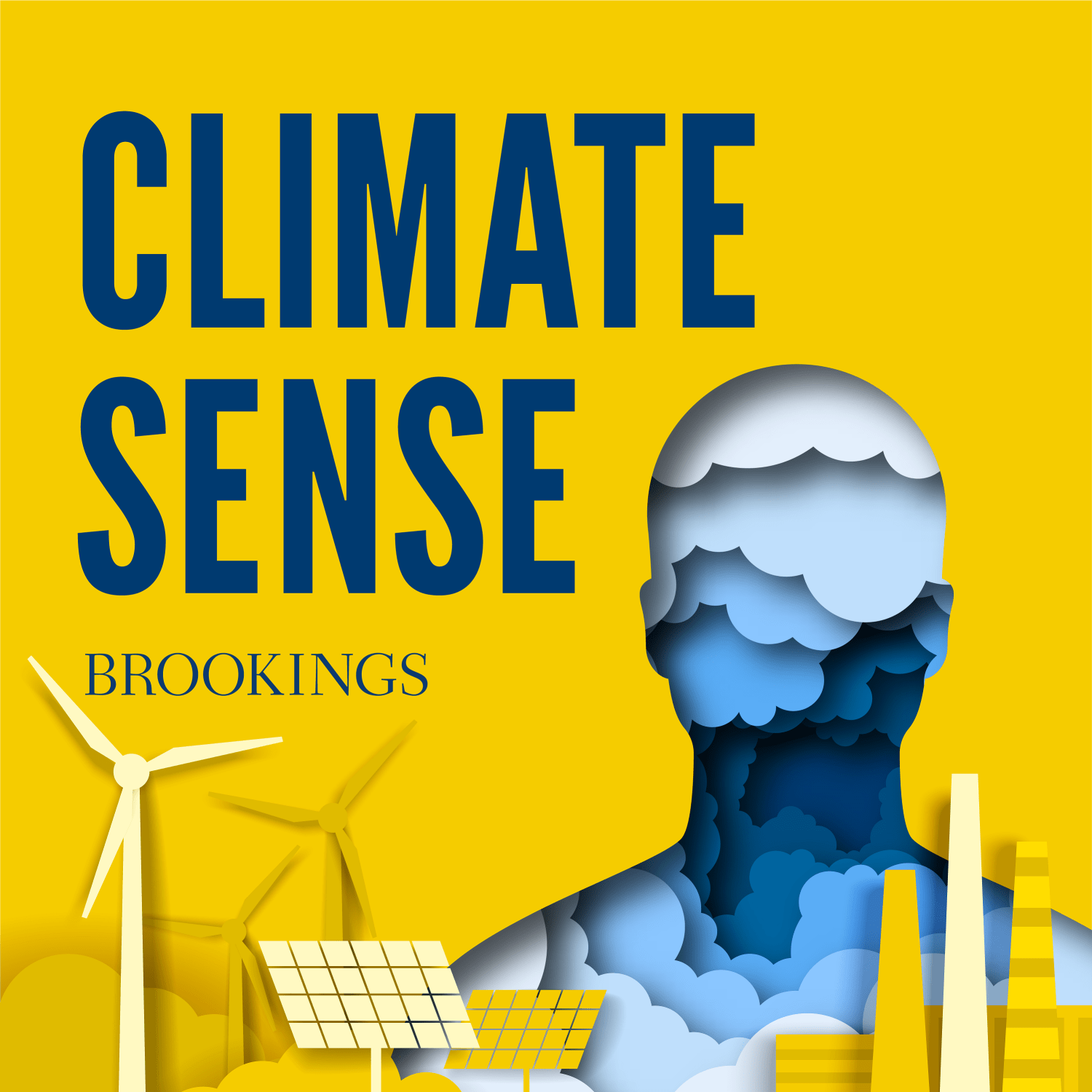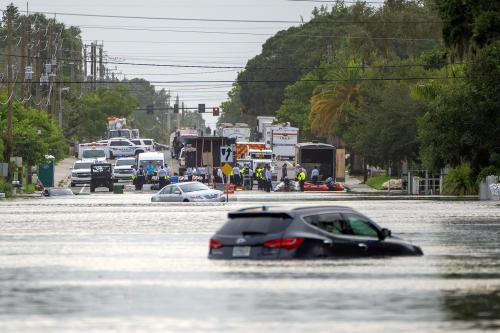China is the world’s largest emitter of greenhouse gases, so clearly it must be involved in any effort to minimize climate change. But relations between the United States and China have gotten much more challenging in the last few years. Host Samantha Gross speaks with Heidi Crebo-Rediker from the Council on Foreign Relations and Eyck Freymann of Stanford’s Hoover Institution about China’s views and actions on climate change and whether there is room for cooperation between the two countries.
- Listen to Climate Sense on Apple, Spotify, or wherever you like to get podcasts.
- Learn about other Brookings podcasts from the Brookings Podcast Network.
- Sign up for the podcasts newsletter for occasional updates on featured episodes and new shows.
- Send feedback email to [email protected].
TRANSCRIPT
FREYMANN: China’s view is that climate change is not fundamentally an environmental issue, it is a development issue.
[music]
GROSS: China and the United States are the two largest emitters of greenhouse gases today. Clearly, real solutions to climate change need to include actions in both countries. And you’ll remember from last season’s episode with Todd Stern that the U.S. and China cooperated in 2014 to launch the process that led to the Paris Agreement.
But since then, the relationship between the two countries has gotten much worse. How is China approaching climate change and is there room for cooperation with the United States?
[music]
I’m Samantha Gross. I’m the director of the Energy Security and Climate Initiative at the Brookings Institution and I’ve spent my career focused on energy and environmental issues. I’ve been in Washington for more than 20 years now, working on energy policy in government and private industry before I came to Brookings. But I started my career as an engineer, designing technical solutions to environmental problems. My work now focuses on how to transition to a clean, zero-carbon energy system—the technical, political, and social challenges in getting from here to there.
The relationship between the U.S. and China has gotten really challenging, a rivalry between powers that plays out in all facets of our relationship. But some hope that climate change is such an existential threat to both countries that we’ll find a way to cooperate on finding solutions. I’ve asked today’s first guest to fill us in on the state of the relationship with respect to climate.
[1:51]
FREYMANN: My name is Eyck Freymann. I’m a Hoover Fellow at Stanford University. I am a China specialist by training. And I work on a lot of issues surrounding contemporary U.S.-China relations, climate change being just one of them.
The U.S.-China relationship on climate right now is not nonexistent, but it is close to nonexistent. And people who follow it carefully have one set of talking points that they’ll use to describe the hoped-for end state. But if they’re being honest, they have a different set of talking points, which they’ll use in private with their colleagues to describe the actual state of affairs, which is bad and getting worse.
The fact is climate change has become intertwined with all of the other aspects of the U.S.-China rivalry. And we are now seeing that play out in a visible way in the trade domain. But it’s not just trade. It has to do with U.S.-China rivalry around the world and critical minerals. It has to do with the Arctic and the Western Pacific, and a region that is growing in importance as we think about Taiwan contingencies. It has to do with China’s relationship with Russia, China’s energy security, America’s energy security, America’s relationship with Europe.
So, climate change is just inseparable from all of these other issues.
[music]
And while there are many in the United States who have tried to keep climate change on a separate track, the fact is the Chinese side has always been skeptical that climate change and geopolitics could be kept on separate tracks, and they actually said that in public.
So, to those who have been following this closely, it’s a disappointment, but it really shouldn’t be a surprise that things have gotten to where they are.
GROSS: Okay, maybe it’s wishful thinking that the U.S. and China can find a way to separate climate change from other issues that are putting sand in the gears of our relationship. But at some level, at least climate change is an issue where both countries need to act.
But to understand how we got to where we are with respect to climate, it helps to go back to the history of global climate negotiations and the differences in how the U.S. and China have acted and have been treated, right from the beginning.
[4:11]
FREYMANN: If you want to understand the origins of this problem, you have to go back in time to where it all started, which is in Rio in 1992, when the UN Framework Convention on Climate Change was first negotiated. Now, that was an exceptional moment. The Soviet Union had just dissolved. The United States was on top of the world. It was a unipolar moment, and you had a Republican president, George H. W. Bush, leading an international agreement to resolve an emerging issue, climate change, which everyone thought as sort of an extension of the Montreal Protocol that had led to a breakthrough on the ozone layer.
So, this was something that was met with a lot of fanfare. And because of the United States’ unique optimism and confidence at that moment, the U.S. signed up for language that was very sweeping, which it would very very soon begin to regret.
The language that was negotiated in Rio was that developed and developing countries had common but differentiated responsibilities to deal with the climate problem.
[music]
And the treaty actually divided the world’s countries into two lists, developed and developing. And it said, explicitly, that developed countries had the responsibility to solve the carbon mitigation problem. And that developing countries had the right to prioritize their own development and adaptation to climate change.
GROSS: This theme of developed versus developing nations has come up in many episodes, and is one of the fundamental challenges to international negotiations on climate change. Eyck explains that this challenge has been there since the very beginning.
[6:07]
FREYMANN: The United States very quickly realized that it was not comfortable with the language that it had agreed to at Rio. It realized this in 1997, when the time came to ratify the first international agreement based on the Rio Treaty that would have real teeth, which was the Kyoto Protocol. And in 1997, the Senate passed something called the Byrd-Hagel Amendment, which made a statement, a non-binding resolution, by a vote of 97 to 0 that the United States should not sign any climate agreements that didn’t bind China and India, the two largest developing countries, to carbon targets.
So, right away, there was a contradiction here between the language that the United States government had espoused on the international stage and what was politically viable in the United States, which was frankly not taking any steps to that would harm the U.S. economy in the process of cutting emissions.
And that from the beginning was the thing that began to poison the well.
[music]
Because China’s attitude was, you got us into this multilateral climate process in the first place by promising that you and we would be in separate categories. And now you’re trying to go back on this and saying that you’re going to take steps to cut your emissions only if we do too. But that’s not what you promised. China had very little patience for this.
And China’s view was we don’t have to show that we have patience for this, because the rest of the developing world agrees with us. From the late ‘90s until the mid-2010s, China’s diplomatic strategy was just align ourselves with the bloc of developing countries and say to the other developing countries, do you want the Americans and the other rich developed countries to force you to kneecap your development prospects to cut emissions to solve a problem they created? If you don’t want to do that, align with us. Their attitude was we’re not going to offer concessions, and we don’t have to pretend that we’re going to. Because ultimately, it is the West that is trying to move the goalposts.
GROSS: It’s true that the world’s least developed countries contributed very little to the problem of climate change. And it truly is a justice issue that those of us in the wealthy world do our share to make the investments needed to deal with a changing climate. We talked a lot about this in the episode about climate finance. But the definition of a developing country is problematic, especially since we’re talking about a continuum of development and wealth, not a bright line.
Eyck tells us that China’s developing country view of climate change is central to how it behaves on the world stage.
[8:58]
FREYMANN: The fact is, there was always a tension that was lurking under the surface that was going to emerge, which was the fact that China, and to a lesser extent India, were developing countries. And unless the two of them found ways to mitigate their emissions in the future, it was not going to be possible to contain warming below 2 degrees.
We know from what China said at the time, and from official documents that emerged as pronouncements from the Chinese party state in the ‘90s, that China has a point of view on climate change, that very much thinks of China as a developing country. China’s view is that climate change is not fundamentally an environmental issue, it is a development issue. It is a contradiction, that emerges when economic development creates environmental problems so bad that they begin to constrain further economic development. Now that’s a problem for China’s developmental trajectory.
And climate change is also a problem for China’s development because it creates natural disasters and other problems, which are going to be costly for China as it develops. Since China envisions itself as part of a process of development that is going to continue until the late 2040s, when national rejuvenation is achieved.
So, China believes that in the long term it does have responsibilities to the world, according to the treaty, but in the short term, it very much has the right to prioritize its own development and adaptation, adapting in ways that will allow it to continue developing through climate change.
[music]
And it believes that that is a justified thing, because that is what the Western countries did when they developed in the late 19th and the early 20th centuries.
So, China has approached basically all of its climate policy, both its domestic climate policy and its approach to negotiations, from this perspective. This is completely embedded into the Chinese view of the world, and it’s not going to change.
GROSS: China’s view on climate change may not change, but it’s position in the world has definitely changed. China became the world’s largest emitter of greenhouse gases in 2006, although its emissions per person are still much less than the United States. We think of the least developed countries as having contributed very little to the problem, which is completely true. But there are now countries on the UN Framework Convention on Climate Change “developing country” list that are very significant emitters. The top 10 emitters list includes not just China, but also India, Indonesia, Brazil, and Iran.
[11:41]
FREYMANN: Is China facing international pressure as China’s emissions continue to rise? The answer to that is yes. And the inflection point happened sometime in the early 2010s, in the late Obama administration. And that was a turning point, you can probably date it to around 2014, when China recognized that it was going to have to accept some cap on its carbon emissions, even if it wasn’t going to follow the same trajectory as the West.
And one of the reasons that China became more willing to negotiate with Obama was not just that they liked Obama or were interested in cooperation with the United States. It was fundamentally that in 2012, 2013, 2014, there were massive protests across China from urbanites who were unhappy with the air pollution. And the Chinese government began to realize this is unsustainable in terms of the stability of our regime. We’re going to have to shut down some of these coal plants and find less dirty sources of power, not because of climate change, but because of particulate pollution in the air in our major cities.
And it was because China ran the numbers and calculated, hmm, if we do these things that we were gonna do anyway, we will be peaking our emissions around 2030 anyway, that they realized they could get a freebie and have the opportunity to make an agreement with the United States, which would be fundamentally asymmetrical—the U.S. would have to start cutting basically immediately, China would get to peak its emissions in the future—but would make some symbolic statement that China was willing to participate in the process.
[music]
So, I think you can think about the Paris Agreement from China’s perspective through that lens. It was mainly promising things that China believed it was going to do anyway and trying to get some diplomatic goodwill in the process.
And many in the rest of the world misunderstood China’s intentions. But if you look at the literature and what China’s experts were saying at the time, it’s very clear that that’s how China saw things.
GROSS: To now, we’ve focused on how China views climate change as a geopolitical issue and how China behaves on the stage of international negotiations, focusing on its role as the leader of developing countries. But there’s another key aspect of China’s response to climate change that we need to explore. Along with many other nations, China also views climate change as a huge economic opportunity.
[14:10]
FREYMANN: China understands that climate change is intertwined with the story of China’s long-term development. They understand that climate change is creating a growing set of problems, both direct problems like natural disasters, and indirect problems, which include instability in other parts of the world, geopolitical pressure from other countries to cut their emissions and change their growth model, lots of other negative or challenging trends.
At the same time, climate change presents a sort of opportunity, an opportunity to reimagine China’s growth model from producing essentially low-value goods in a highly polluting way, to higher value goods in a less polluting way to generate more jobs, higher paying employment, and to capture more export markets around the world.
So, China recognized that partly as a result of climate change the rest of the world would inevitably decarbonize and that there was a basket of technologies that would probably be involved with that from solar photovoltaics to wind and electric cars. And China recognized that by gaining some competitive advantages in those industries before those industries had really significant parts of the global energy mix, it could corner the industries of the future.
It could also in the process resolve something that Chinese national security planners spend most of their time worrying about, which is the country’s energy security. The fact that China is extremely dependent and increasingly dependent on imported oil and gas.
GROSS: We in the United States are certainly familiar with concerns about energy security. It’s easy to forget now that we are the world’s largest producer of both oil and natural gas, but as recently as 15 years ago, the United States was in the same boat, concerned about our reliance on imported energy.
[16:03]
FREYMANN: So, this was a plan that served multiple goals at once. Starting in the early 2000s, the Chinese government began to engage in industrial policy at a massive scale to support a wide range of technologies that might prove to be important for the green transition. They gave tax breaks. They gave subsidized land. They gave advantages in terms of government procurement. They leaned on grid operators to buy electricity from green sources.
They took all these efforts that essentially meant that green energy, new energy producers in China were subject to soft profit constraints.
[music]
If they lost money, it wasn’t the big deal because they would be subsidized or bailed out later. They were incentivized to take risks, and they used their provinces and their cities as laboratories of innovation. Not all of these ventures worked. In fact, a lot of them failed. And China spent an enormous amount of capital to make it happen.
But as a result of all this process, there’s a few key green industries where China has emerged as a decisive global leader. Solar photovoltaics, lower- to medium-end electric vehicles, and batteries are three of those areas.
Now, part of the advantage has to do with economies of scale. When you make large quantities of these things, you can make them for a lower unit price. And because these companies enjoyed preferential access to China’s vast market, they could make the investment to scale up production. And eventually, as a result of these things, advantages compounded, and Chinese firms left their international competitors in the dust.
Now that’s a good thing from the perspective of bringing down global emissions as fast as possible. We should be happy that China has done this work and paid this price up front to bring down the price of low-carbon products.
But there’s a catch. Which is that ultimately, if China is making more of these products than they are consuming themselves, then other countries have to become dumping grounds for the Chinese products, and the United States and the European Union, and other countries that would like to be the centers of industry for this new economy are losing out because they’re unable to compete on price. So, the result is that the process of going green is unleashing new trade tensions, and this is ultimately just another one of the ways in which climate change and geopolitics are interlinked.
GROSS: You can see China’s contribution to manufacturing of clean energy products in two diametrically opposed ways. On the one hand, we should thank China for applying its manufacturing skill to products we need for the energy transition. The cost of solar panels came down more than 90% over a decade, in large part due to Chinese manufacturing. On the other hand, shame on China for using its industrial policy to corner the market on these products and push out competitors. These are completely different ways of reading the same set of facts. And there is some truth in both of them.
I asked an economist to fill us in on the effects that these Chinese investments have had on other nations, including the United States.
CREBO-REDIKER: My name is Heidi Crebo-Rediker, and I’m an adjunct senior fellow at the Council on Foreign Relations.
GROSS: Heidi’s being a little bit modest here—she had a career in international investment banking before serving as the State Department’s first Chief Economist and as the chief of international finance and economics for the Senate Committee on Foreign Relations.
[19:54]
CREBO-REDIKER: Looking at solar panels, you had a state-led, heavily subsidized production of solar panels out of China that created massive job losses and it actually destroyed many of the industries in the U.S. and Europe. And so, we don’t really have a solar panel production industry anymore. And they’ve gotten so cheap that it doesn’t even make sense for the U.S. or Europe to even invest so much anymore.
It’s unfortunate because you have ecosystems that you lose, innovation ecosystems. If you’re not producing the technology, then that production-innovation production cycle goes along with the job losses.
And in EVs, we’re seeing the same thing. In around 2009, 2010, the EV industry became a strategic emerging industry in China. And so, they are the cutting edge of both the EV and battery innovation industry right now. And they overproduced in the same way that they did in solar panels.
So, you have this massive onslaught of Chinese EVs. We just saw China overtake Europe, Japan, and the U.S. as the world’s leading car exporter last year and everybody was shocked because they’re actually people like the cars. They’re unbelievably inexpensive.
So, you could say to diversify supply chains and move away from China, it is you could argue at odds with a fast energy transition.
GROSS: This is the first part of my two-part argument on China’s industrial policy. China has made achieving the transition toward a zero-carbon economy cheaper and faster by investing so heavily in industries like solar panels and electric vehicles.
But as Eyck said earlier, there’s a catch. Heidi explains.
[21:45]
CREBO-REDIKER: But, if you fast forward and see what happened in the solar panel industry and you think what might happen to the auto industries in the U.S. and Europe, that is a much more daunting picture. So, if you lose your auto industry, if Germany loses its auto industry, a lot of its competitive advantage, and the U.S. sees its auto industry really significantly challenged, that’s a big deal.
So, I think it’s happening very fast. Chinese brands in Europe have jumped from, like, zero to more than 10 percent since 2020. That’s four years. We saw BYD in Europe last year go from 0 percent to 8 percent in one year of total cars in Europe sold.
And we already have tariffs on Chinese cars in place. But watch this space because China’s dominating in both battery technology and in car manufacturing. And they’re producing good cars and they’re highly highly innovative. And so, I think it’s that balance between energy transition and moving away from China. Also, you have to weave in the fact that if you lose an industry, that you lose the innovation cycle as well.
So, it’s a tough one, but I have a feeling that policymakers are really going to lean in the same direction, which is that they don’t want their industries destroyed.
And the competition right now between Chinese EV manufacturers is intense. It’s probably the intense competition on the planet in terms of cutting prices down to the bare bones to produce the best car for the money.
[music]
And so, I think they’re looking for competition to actually, solve for the domestic issue in China. But the flip side is that all those cars are being exported. All the ones that couldn’t be sold domestically in China are being exported right now.
GROSS: A glut of inexpensive, government-subsidized electric vehicles in the global market could be good for the climate, but terrible for car manufacturers in the United States, Europe, and elsewhere. We live in a democracy, so keeping jobs and industry here in the United States will be crucial to maintain political support for action on climate change.
This is an area where our relationship with China really gets tricky. Do we want Chinese goods more, to allow us to decarbonize more quickly and cheaply? Or do we want to maintain our industrial base? Politically, maintaining our industrial base will usually win. And we’re frustrated watching China lead in areas where the United States has led in the past, like in advanced technologies.
But given that China already is producing an oversupply of solar panels and electric vehicles, where are they going to go? Here’s Eyck again to explain.
[24:49]
FREYMANN: The United States has a domestic political consensus that we should decarbonize only insofar as it advances our interests. And the way that’s understood in Washington these days is creating high paying manufacturing jobs in key sectors, and the auto sector is one of them.
So, inevitably, once China gained the ability to produce electric vehicles that were good enough to sell in the United States, electric vehicles that American consumers would want to buy over a Chevy or a Ford, there was going to be a trade confrontation and U.S. parochial economic interests were going to win.
GROSS: And as Heidi pointed out, the United States has a 100% tariff on Chinese electric vehicles to protect the U.S. market. Canada has recently added a 100% tariff too.
[25:43]
FREYMANN: But there’s an enormous alternative market for Chinese new energy products in the developing world. Now, developing countries, as we know, have different energy needs. And a lot of them are in a position where they’re not really prioritizing the carbon footprint of energy projects. They just need energy that is cheap and reliable. That’s why China has been engaged in building coal plants around the developing world.
But increasingly as electrification continues, there is a market for Chinese new energy products in the developing world, especially in countries like in Southeast Asia that are already economically integrated with China. But the choice that these countries are going to have to make, and you’re already beginning to see this trend, is do they want new energy industry of their own? Because if they do, they’re going to have to put up trade barriers to protect their market. That’s why India, which is going all in on solar—so the Indian government says—has put an almost total block on Chinese solar PV components.
So, I think we are looking not at the decoupling of China from the rest of the world—what you could call the bifurcation of the world. It’s the fragmentation of the global supply chain where every major economy that is either industrialized or industrializing is going to want to put up sufficient trade barriers that it can ensure that its domestic industries are protected.
[music]
That is inevitably going to make prices for green energy higher than they would otherwise have been. So, in a sense, that’s going to slow down the green transition.
On the other hand, because you have multiple countries that are trying to build industrial bases independently to compete against each other, and you have the state throwing money to incentivize surplus capital investment, the economists would predict an excess of investment in these industries, which should lead to oversupply for a lot of components and parts. That’s a subsidy which would bring prices down.
So, there’s a lot of inefficiencies that are involved in the way things are developing. But in the short term, in terms of spurring the world towards decarbonization, it’s not necessarily a bad thing.
GROSS: Wow! This certainly would not be an economist’s dream world. Eyck is describing serious inefficiencies in the markets for goods involved in decarbonization.
But maybe the most economically efficient solution to climate change isn’t politically possible. Relying on China to make inexpensive electric vehicles to transform U.S. transportation is a huge loser politically, and also could be very harmful to the economy and jobs. Decarbonization can’t be our only goal. Everything we do to deal with climate change has to consider the rest of our political economy. We’re not solving for only one variable here.
Here in the U.S., we tend to think of the world in terms of how it relates to us. But other countries in the world, China in particular, don’t view the world in the same way that we do. This difference in world view can make cooperation on issues difficult. In particular, the developing world is often more focused on adapting to the climate change that is already happening, rather than mitigating climate change through reducing emissions. The least developed countries have very few emissions to mitigate anyway.
[29:19]
FREYMANN: China has said since the ‘90s that mitigation and adaptation are equally important. And I think China means that. I think China thinks that the West has decided that mitigation is somehow much more important than adaptation and development. But adaptation and development are two sides of the same coin, because as you develop your infrastructure gets higher and higher quality and you get more resilient to natural disasters. And as you get richer, you get more resources to build resilience and to recover from natural disasters.
So, when China says that it regards mitigation and adaptation as equally important, it also doesn’t mean that China is focusing equal attention on both of those right now. China says they’re equally important in principle, but China as a developing country, according to its international law rights and obligations, is going to prioritize adaptation and development relatively more in the short term. And then once it’s developed, or close to being done with development, it’s going to put more effort into mitigation.
So, in China’s view, its position is entirely consistent with international law and entirely reasonable in response to the science. So, China is going to focus on doing what it has to do to sustain its development now without regard for the emissions intensity of what that requires.
And then it is hoping that when that inflection point comes, and it sees it coming in the late 2020s, early 2030s, when green technology reaches the point where it can actually start to replace rather than supplement fossil fuel energy, China will be prepared to win on the flip and go that last mile for national development by helping the world decarbonize.
[music]
So, China doesn’t see any contradiction of terms there. The thing that’s uncomfortable for the rest of us is that that development model for China, while it makes a lot of sense for China, is not compatible with keeping warming below 2 degrees.
GROSS: I agree with Eyck that the United States and the West are prioritizing mitigation over adaptation to climate change. Until somewhat recently, even talking about adaptation was seen in some circles as an admission of defeat. But as we spoke about in the finance episode, climate change is happening and adaptation is key, especially in developing countries with infrastructure that’s totally not ready for the change.
But when a country as large as China, with emissions as large as China’s, focuses more on adaptation than mitigation, our overall goals are in trouble. The Paris Agreement’s fundamental goal is to keep global average temperature rise below 2 degrees Celsius, and preferably more like 1.5 degrees. This is a tall order given that we’ve already warmed more than a degree, maybe 1.2 or 1.3 degrees.
[32:21]
FREYMANN: If what we’ve just discussed is true, if my reading of the Chinese sources is right, then the world is going beyond 2 degrees. It’s an inevitable fact given the realities of where China was on its development arc when this process began.
And given the fact that we’re headed beyond 2 degrees of warming, all of the great powers are preparing for competition with one another in a world in which there has been more than 2 degrees of warming. In a world in which there has been dramatic dislocations resulting from sea level rise, extreme weather, and all of the other climate impacts we’ve come to know about.
So, if you think about climate anticipation in a geopolitical perspective, then you realize that a lot of what is happening with U.S.-China competition and U.S.-Russia competition in the Arctic, for example, a lot of U.S.-China competition for influence in the Pacific Islands, which are vulnerable to sea level rise, a lot of China’s damming activities and geoengineering activities in Tibet, which are going to affect water flows in riparian South and Southeast Asia—all of these are connected to an emerging geopolitics of climate change, which touches every region of the world.
[music]
And comes from the fact that states are smart, and they can look at the numbers, and they can see where the climate is headed, and they recognize that their political strategies, their military strategies, as well as their economic strategies have to follow.
Adaptation to climate change is something that will touch all of us. Will touch every country, every sector. And that is wrapped up with U.S.-China competition too. China understands this. It understands this clearly. The United States is beginning to get wise to this. That is something that interests me, that terrifies me, but is, I think, a very important issue that deserves further scrutiny and debate.
GROSS: Eyck raises some difficult questions for our politics. We need to do everything we can to reduce greenhouse gas emissions and head off the worst impacts of climate change, while at the same time living in the real world and preparing for the changes we’re bound to see. This isn’t just a question of environmental change, but geopolitical and economic competition too. This is a tricky, nuanced world to navigate.
[music]
Many thanks to the experts I talked to in this episode.
Climate Sense is brought to you by the Brookings Podcast Network. Fred Dews is the producer; Gastón Reboredo the audio engineer. Thanks also to Kuwilileni Hauwanga, Daniel Morales, and Louison Sall, and to the communications teams in Brookings Foreign Policy and the Office of Communications. Show art was designed by Shavanthi Mendis.
You can find episodes of Climate Sense wherever you get your podcasts and learn more about this show at Brookings dot edu slash Climate Sense Podcast. You’ll also find my work on climate change and research from the Brookings Initiative on Climate Research and Action on the Brookings website.
I’m Samantha Gross, and this is Climate Sense.
The Brookings Institution is committed to quality, independence, and impact.
We are supported by a diverse array of funders. In line with our values and policies, each Brookings publication represents the sole views of its author(s).







Commentary
PodcastChina and climate change—cooperation or rivalry?
Listen on
Climate Sense Podcast
October 10, 2024